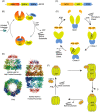Heat shock proteins: Biological functions, pathological roles, and therapeutic opportunities
- PMID: 35928554
- PMCID: PMC9345296
- DOI: 10.1002/mco2.161
Heat shock proteins: Biological functions, pathological roles, and therapeutic opportunities
Abstract
The heat shock proteins (HSPs) are ubiquitous and conserved protein families in both prokaryotic and eukaryotic organisms, and they maintain cellular proteostasis and protect cells from stresses. HSP protein families are classified based on their molecular weights, mainly including large HSPs, HSP90, HSP70, HSP60, HSP40, and small HSPs. They function as molecular chaperons in cells and work as an integrated network, participating in the folding of newly synthesized polypeptides, refolding metastable proteins, protein complex assembly, dissociating protein aggregate dissociation, and the degradation of misfolded proteins. In addition to their chaperone functions, they also play important roles in cell signaling transduction, cell cycle, and apoptosis regulation. Therefore, malfunction of HSPs is related with many diseases, including cancers, neurodegeneration, and other diseases. In this review, we describe the current understandings about the molecular mechanisms of the major HSP families including HSP90/HSP70/HSP60/HSP110 and small HSPs, how the HSPs keep the protein proteostasis and response to stresses, and we also discuss their roles in diseases and the recent exploration of HSP related therapy and diagnosis to modulate diseases. These research advances offer new prospects of HSPs as potential targets for therapeutic intervention.
Keywords: cancers; heat shock proteins; molecular chaperone; proteostasis; target therapy.
© 2022 The Authors. MedComm published by Sichuan International Medical Exchange & Promotion Association (SCIMEA) and John Wiley & Sons Australia, Ltd.
Conflict of interest statement
The authors declare no competing interests.
Figures




Similar articles
-
The Interplay between Heat Shock Proteins and Cancer Pathogenesis: A Novel Strategy for Cancer Therapeutics.Cancers (Basel). 2024 Feb 1;16(3):638. doi: 10.3390/cancers16030638. Cancers (Basel). 2024. PMID: 38339390 Free PMC article. Review.
-
Heat Shock Proteins and Breast Cancer.Int J Mol Sci. 2024 Jan 10;25(2):876. doi: 10.3390/ijms25020876. Int J Mol Sci. 2024. PMID: 38255948 Free PMC article. Review.
-
Structure, gene expression, and putative functions of crustacean heat shock proteins in innate immunity.Dev Comp Immunol. 2021 Feb;115:103875. doi: 10.1016/j.dci.2020.103875. Epub 2020 Sep 25. Dev Comp Immunol. 2021. PMID: 32987013 Review.
-
General Structural and Functional Features of Molecular Chaperones.Adv Exp Med Biol. 2021;1340:11-73. doi: 10.1007/978-3-030-78397-6_2. Adv Exp Med Biol. 2021. PMID: 34569020
-
Recent advances in heat shock proteins in cancer diagnosis, prognosis, metabolism and treatment.Biomed Pharmacother. 2021 Oct;142:112074. doi: 10.1016/j.biopha.2021.112074. Epub 2021 Aug 20. Biomed Pharmacother. 2021. PMID: 34426258 Review.
Cited by
-
Integrative transcriptomic profiling uncovers immune and functional responses to bisphenol a across multiple tissues in male mice.Anim Cells Syst (Seoul). 2024 Oct 24;28(1):519-535. doi: 10.1080/19768354.2024.2419473. eCollection 2024. Anim Cells Syst (Seoul). 2024. PMID: 39464840 Free PMC article.
-
Relevance of the Adjuvant Effect between Cellular Homeostasis and Resistance to Antibiotics in Gram-Negative Bacteria with Pathogenic Capacity: A Study of Klebsiella pneumoniae.Antibiotics (Basel). 2024 May 26;13(6):490. doi: 10.3390/antibiotics13060490. Antibiotics (Basel). 2024. PMID: 38927157 Free PMC article. Review.
-
Evaluation of serum levels of heat shock protein 70 in patients with psoriasis in Basra, Iraq.Prz Menopauzalny. 2024 Jun;23(2):64-68. doi: 10.5114/pm.2024.141089. Epub 2024 Jul 4. Prz Menopauzalny. 2024. PMID: 39391523 Free PMC article.
-
Crossroad between the Heat Shock Protein and Inflammation Pathway in Acquiring Drug Resistance: A Possible Target for Future Cancer Therapeutics.Biomedicines. 2023 Sep 26;11(10):2639. doi: 10.3390/biomedicines11102639. Biomedicines. 2023. PMID: 37893013 Free PMC article. Review.
-
Genome-Wide Identification, Molecular Characterization, and Expression Analysis of the HSP70 and HSP90 Gene Families in Thamnaconus septentrionalis.Int J Mol Sci. 2024 May 24;25(11):5706. doi: 10.3390/ijms25115706. Int J Mol Sci. 2024. PMID: 38891896 Free PMC article.
References
-
- Richter K, Haslbeck M, Buchner J. The heat shock response: life on the verge of death. Mol Cell. 2010;40(2):253‐266. - PubMed
-
- Ellis RJ. Protein misassembly: macromolecular crowding and molecular chaperones. Adv Exp Med Biol. 2007;594:1‐13. - PubMed
-
- Balch WE, Morimoto RI, Dillin A, Kelly JW. Adapting proteostasis for disease intervention. Science. 2008;319(5865):916‐919. - PubMed
-
- Hartl FU, Bracher A, Hayer‐Hartl M. Molecular chaperones in protein folding and proteostasis. Nature. 2011;475(7356):324‐332. - PubMed
Publication types
LinkOut - more resources
Full Text Sources
Other Literature Sources
Research Materials
Miscellaneous
